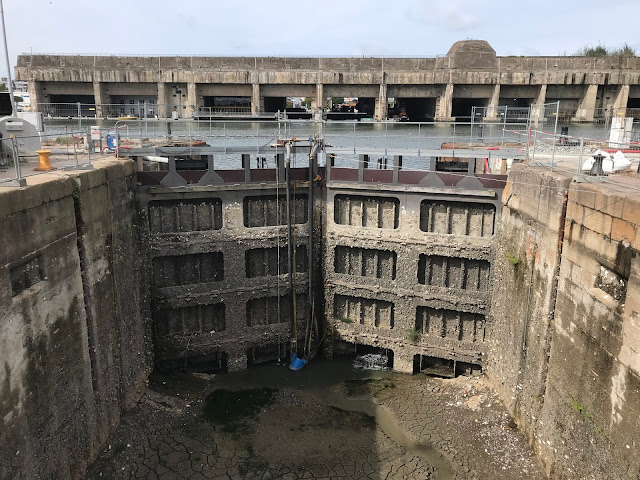I recently was fortunate enough to visit the scene of Operation
Chariot – the Commando raid on St. Nazaire to deny the enemy use of the
Normandie Dry Dock - the only dry dock on the Atlantic Coast of France that was capable of housing the Tirpitz.
 |
| The main U-Boat pen looking across from the single U-Boat pen that now stands near the old entrance to the Bassin de St. Nazaire, next to the Normandie Dock. |
The area where the raid took place also contains the well preserved
concrete re-enforced U-Boat pens that were constructed from 1940 by the occupying
German forces.
 |
| Inside the main U-Boat pens - now a lifeboat station. |
The plan for the raid was simple in concept, but difficult
to execute.
 |
| Plan of the area of the Commando Raid as it was in 1942 (Source: en:Image:Stnz opchr 1942.png by en:user:TwoOneTwo Licence: GNU/FDL) |
 |
| Signs of damage to the concrete walls |
The Commandos were to destroy 2 pumping houses and one winch
house that served the dry dock, and the dock itself was to be put out of action
by ramming the gates with an obsolete destroyer (HMS Cambletown) that was
packed with high explosives.
 |
| The pens now house two permanent museums (not WW2 based surprisingly!) as well as souvenir shops, tourist office and a Bistro! |
The difficult bit was that St. Nazaire harbour is 6 miles
into the heavily defended Loire Estuary.
 |
| The Main U-Boat pens as seen from the area next to the old entrance gates to the Bassin de St. Nazaire, near to where the Commandos came ashore from the old mole. |
 |
| The old mole (with lighthouse) where Commandos came ashore. |
The raid was a success in that all objectives were achieved,
but costly in men lost - of the 611 men who undertook the raid, 228 returned to
Britain, 169 were killed and 215 became prisoners of war.
 |
| The gate to the Normandie Dry Dock today (with blue control cabin on top). The new Loire Estuary bridge can be seen in the distance. |
German casualties
were over 360 dead, some of whom were killed after the raid when Campbeltown finally
exploded.
 |
| Cambletown's gun was recovered from the dry dock and today stands as a memorial on top of the U-Boat pen near the Normandie Dock. |
Today all is peaceful. The U-Boat pens are larger than they
were at the time of the raid and there is now an additional single pen close to
where Cambletown came to rest, alongside the old entrance gates to the Bassin de St. Nazaire, which was not there then.
 |
| The dock wasn't repaired until 1947. Here the remains of Cambletown can be seen still lying in the dry dock. (RAF - Imperial War Museum (Reference Number: C3398)) |
The dry dock is still in use and today can accommodate ocean
going cruise ships in for repair.
 |
| The old entrance gates to the Bassin de St. Nazaire, opposite the U-Boat pens today, give you some impression what those destroyed by Cambletown may have looked like. |
The Town of St. Nazaire has been extensively rebuilt since
WW2 due to the damage it suffered during numerous RAF raids attempting (and
failing) to destroy the U-Boat pens.
 |
| As well as the raid, St. Nazaire also remembers the loss of the Lancastria in 1940 a few miles off shore with the largest ever loss of life recorded for a British Civilian ship lost at sea. |
Well worth a visit if you find yourself in the area. To
follow the course of the raid on foot is easily achieved and access to both
sets of U-Boat pens is free. If you are prepared to walk a few extra metres you
can find free car parking too.
 |
| Tobruk position in the single U-Boat pen that overlooks the old mole. |
 |
| The main flak Tower |



Thanks Tim for report ad pictures !
ReplyDeleteWe must go there !
:-)
Yes you will enjoy. It is well worth the trip.
Delete